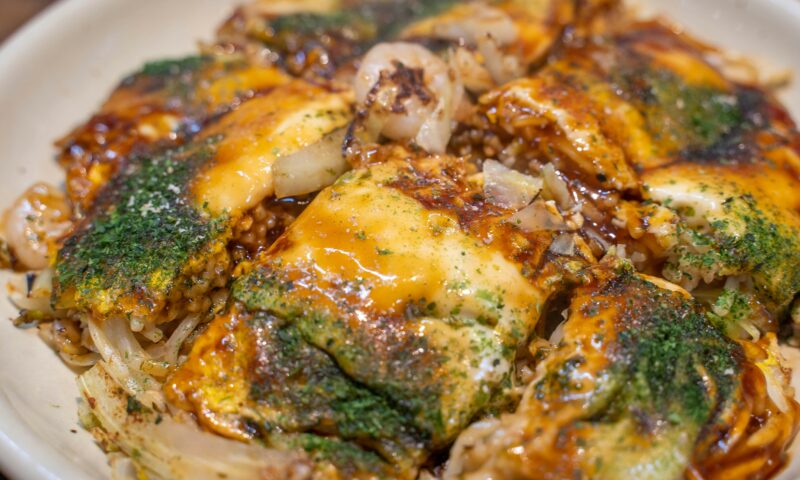Japan’s culinary landscape is filled with delightful surprises, and Omusoba (オムそば) is one of Osaka’s hidden treasures that deserves the spotlight. Imagine savory, stir-fried yakisoba noodles lovingly wrapped in a delicate, fluffy omelet—creating a harmonious marriage of textures and flavors that exemplifies Japanese comfort food at its finest. Join us as we explore this lesser-known but utterly delicious Osaka specialty that’s been winning the hearts of locals for decades.
- What is Omusoba? The Perfect Fusion Dish
- Osaka’s Food Culture: The Birthplace of Omusoba
- The Art of Creating Omusoba: Technique Matters
- The Cultural Significance: More Than Just a Meal
- Regional Variations: How Omusoba Changes Across Japan
- Omusoba in America: Finding and Enjoying This Osaka Specialty
- Make Your Own: A Home Recipe for Omusoba
- Beyond Omusoba: Exploring Osaka’s Rich Food Culture
- Conclusion: Embracing Omusoba’s Comforting Charm
What is Omusoba? The Perfect Fusion Dish
Omusoba (ohm-soh-bah) combines two beloved Japanese dishes: yakisoba (stir-fried noodles) and omelet. Taking inspiration from the more internationally famous omurice (omelet with rice), omusoba swaps out the rice filling for flavorful yakisoba noodles. The result is a delicious study in contrasts—the soft, fluffy texture of the egg embracing the slightly chewy, savory-sweet noodles within.
The dish is typically served with a drizzle of special sauce (often a combination of tonkatsu sauce, ketchup, and mayonnaise), creating a visually appealing presentation that’s as Instagram-worthy as it is delicious. While omurice might be the more famous egg-wrapped dish internationally, omusoba holds a special place in Osaka’s food culture as a satisfying, hearty meal that showcases the region’s playful approach to casual dining.
Key Elements of Authentic Omusoba:
- Perfect yakisoba: Stir-fried noodles seasoned with a distinctive sweet-savory sauce
- Fluffy omelet: Thin yet substantial egg wrapper with a slightly runny interior
- Toppings: Often garnished with aonori (seaweed flakes), beni shoga (red pickled ginger), and mayonnaise
- Sauce: A harmonious blend that typically includes elements of both Western and Japanese condiments
Osaka’s Food Culture: The Birthplace of Omusoba
To understand omusoba is to understand Osaka itself—a city that proudly holds the nickname “Japan’s kitchen” (天下の台所, tenka no daidokoro). Throughout Japanese history, Osaka has been a merchant city, where practicality, value, and flavor reign supreme. This commercial heritage has shaped Osaka’s distinctive food culture, which emphasizes filling, affordable, and deeply satisfying cuisine.
Osakans are known for their love of kuidaore—a term that literally means “to eat oneself into bankruptcy.” This passion for good food has made Osaka one of Japan’s premier culinary destinations, famous for street foods and casual dining experiences that deliver maximum flavor without pretension.
Did you know? Osaka is the birthplace of many beloved Japanese dishes beyond omusoba, including takoyaki (octopus balls), okonomiyaki (savory pancakes), and kushikatsu (deep-fried skewered meats and vegetables). The city’s food culture emphasizes bold flavors, creative combinations, and hearty portions.
Omusoba emerged from this tradition, likely as an innovative variation of omurice created by resourceful street food vendors or small family restaurants looking to diversify their menus. Like many Osaka specialties, it combines familiar elements in a new, accessible, and delicious format that appeals to hungry diners looking for something satisfying and affordable.
The Art of Creating Omusoba: Technique Matters
Making omusoba might seem straightforward, but achieving the perfect balance of textures requires skill. The yakisoba must be flavorful but not too wet (which would make the omelet soggy), while the omelet needs to be cooked just enough to hold together while remaining tender.
Perfecting the Yakisoba Base
Traditional yakisoba uses Chinese-style wheat noodles that are stir-fried with vegetables like cabbage, carrots, and onions, often with small pieces of pork or other proteins. The distinctive flavor comes from yakisoba sauce—a sweet and savory condiment similar to Worcestershire sauce but adapted to Japanese tastes.
For omusoba, the yakisoba is typically made slightly drier than it would be when served on its own, ensuring the egg wrapper doesn’t become soggy. The noodles are usually cooked until they develop some caramelized bits, adding depth of flavor to the final dish.
The Delicate Egg Wrapper
Creating the perfect omelet wrapper is perhaps the most challenging aspect of omusoba. Unlike a standard Western omelet that’s folded over fillings, the Japanese-style omelet used for omusoba is typically thinner and more delicate, often with a slightly runny interior that creates a luscious sauce when cut into.
In skilled hands, the omelet is cooked quickly over high heat, swirled in the pan to create a thin, even layer, and then carefully wrapped around the prepared yakisoba. Some chefs add a small amount of dashi (Japanese stock) or milk to the beaten eggs to enhance the flavor and texture.
“The perfect omusoba should have a gentle contrast—the egg should yield softly to reveal the satisfying chew of the noodles within.” — Osaka street food vendor
The Cultural Significance: More Than Just a Meal
Omusoba, like many regional specialties in Japan, represents more than just a tasty dish—it embodies aspects of local identity and values. In Osaka particularly, food is intrinsically linked to the concept of mottainai (waste nothing) and kuiadore (eat until you drop), reflecting the city’s merchant history and pragmatic approach to life.
Casual Dining and Social Connection
Dishes like omusoba are typically enjoyed in casual settings—small family restaurants, food stalls, or at home. They represent the democratic side of Japanese cuisine, accessible to everyone regardless of economic status. These unpretentious foods often create spaces for social connection, where friends and family can gather without the formality that sometimes accompanies Japanese dining traditions.
Yōshoku Influence
Omusoba falls into the category of yōshoku—Western-influenced Japanese cuisine that developed during the Meiji era (1868-1912) when Japan began opening to Western influences. Like omurice, tonkatsu (breaded pork cutlet), and korokke (croquettes), omusoba represents Japan’s remarkable ability to adapt foreign culinary concepts and transform them into something uniquely Japanese.
This adaptive creativity is a hallmark of Japanese culture, reflecting a society that has historically been skilled at borrowing elements from other cultures and refining them according to Japanese aesthetics and tastes.

Regional Variations: How Omusoba Changes Across Japan
While omusoba is primarily associated with Osaka, variations of this dish can be found throughout Japan, each reflecting local ingredients and preferences:
- Tokyo-style: Often more precisely plated with a smoother omelet exterior and additional Western-influenced sauces
- Hiroshima-style: Sometimes incorporates elements of Hiroshima-style okonomiyaki, with layers of cabbage and optional seafood
- Hokkaido: May include local seafood like scallops or crab in the yakisoba filling, with a heartier, butter-enriched omelet
- Kyushu: Occasionally features spicier yakisoba with local specialty ingredients like mentaiko (spicy cod roe)
These regional adaptations showcase the Japanese concept of donburi bunka (bowl culture)—the tendency to create versatile, complete meals that combine various elements in a single serving. While technically not served in a bowl, omusoba follows this philosophy by creating a complete, satisfying meal in a single dish.
Omusoba in America: Finding and Enjoying This Osaka Specialty
As Japanese cuisine continues to gain popularity in the United States, more regional specialties like omusoba are beginning to appear on restaurant menus, particularly in cities with large Japanese populations such as Los Angeles, Seattle, New York, and San Francisco.
Where to Find Omusoba in America
While still less common than dishes like ramen or sushi, omusoba can sometimes be found at:
- Osaka-style Japanese restaurants: Establishments specifically focusing on Kansai region cuisine
- Japanese comfort food restaurants: Places specializing in yoshoku or casual Japanese dining
- Japanese food festivals: Cultural events celebrating regional Japanese cuisines
- Food halls with Japanese vendors: Modern food courts featuring diverse Japanese offerings
When seeking authentic omusoba, look for restaurants that emphasize Osaka cuisine or that are owned by chefs from the Kansai region. Social media and food blogs focused on Japanese cuisine can also be excellent resources for finding this specialty dish in American cities.
What to Look for in Authentic Omusoba:
- Noodles with good texture—neither too soft nor too firm
- An omelet that’s thin yet sturdy enough to contain the filling
- A balance of sweet and savory flavors in the sauce
- Traditional garnishes like aonori (seaweed flakes) and beni shoga (pickled ginger)
- A presentation that allows the omelet to shine, typically with a drizzle of sauce on top
Make Your Own: A Home Recipe for Omusoba
Homemade Omusoba Recipe
Serves 2
For the Yakisoba:
- 2 packages (about 7 oz each) fresh yakisoba noodles (found in Asian markets; ramen noodles can substitute in a pinch)
- 1/2 small cabbage, thinly sliced
- 1 medium carrot, julienned
- 1 small onion, thinly sliced
- 2 green onions, chopped
- 4 oz pork belly or bacon, thinly sliced (optional)
- 2 tablespoons vegetable oil
- 3 tablespoons yakisoba sauce (or mix 2 tbsp Worcestershire sauce, 1 tbsp ketchup, 1 tsp soy sauce, and 1/2 tsp sugar)
For the Omelet:
- 6 large eggs
- 2 tablespoons milk
- Pinch of salt
- 2 tablespoons vegetable oil
For the Sauce and Garnish:
- 2 tablespoons tonkatsu sauce or okonomiyaki sauce
- 2 tablespoons mayonnaise (preferably Japanese Kewpie mayo)
- 1 tablespoon ketchup
- Aonori (seaweed flakes) for garnish
- Beni shoga (red pickled ginger) for garnish
Method:
- Prepare the yakisoba: Heat 1 tablespoon oil in a large skillet over medium-high heat. If using meat, cook it first until lightly browned. Add onions and carrots and sauté for 2 minutes. Add cabbage and cook for another 2 minutes until vegetables are tender but still crisp.
- Add the noodles to the pan, breaking them up with chopsticks or tongs. Pour the yakisoba sauce over the noodles and stir-fry everything together for about 3-4 minutes until the noodles are heated through and slightly caramelized. Divide the yakisoba into two portions and keep warm.
- Make the omelet: For each serving, beat 3 eggs with 1 tablespoon milk and a pinch of salt. Heat 1 tablespoon oil in a 10-inch non-stick skillet over medium heat.
- Pour the egg mixture into the pan, tilting to create a thin, even layer. When the egg is mostly set but still slightly runny on top (about 2 minutes), place one portion of the yakisoba in the center of the omelet.
- Using a spatula, carefully fold the edges of the omelet over the yakisoba to create an oval shape. Gently slide onto a serving plate, seam-side down.
- Prepare the sauce: Mix the tonkatsu sauce, mayonnaise, and ketchup in a small bowl.
- Drizzle the sauce over the omusoba in a zigzag pattern, sprinkle with aonori and place a small amount of beni shoga on the side.
- Repeat the process for the second serving.
Tips for Omusoba Success:
- Don’t overcook the yakisoba—the noodles should maintain a slight chew
- Keep the heat medium-low when making the omelet to avoid browning it too much
- If you’re nervous about folding the omelet, you can partially fold it in the pan, then complete the wrapping on the plate
- For an authentic touch, look for Japanese ingredients like Kewpie mayonnaise, authentic yakisoba sauce, and aonori at Asian markets
- Try making a smaller version first if you’re new to the technique—use fewer eggs and a smaller pan for easier handling
Beyond Omusoba: Exploring Osaka’s Rich Food Culture
If your interest in omusoba has sparked curiosity about other Osaka specialties, there’s a wealth of delicious dishes to explore:
- Takoyaki: Ball-shaped snacks filled with octopus pieces, tempura scraps, and green onion
- Okonomiyaki: Savory pancakes filled with cabbage, meat, seafood, and topped with a variety of condiments
- Kushikatsu: Skewered and deep-fried meat and vegetables served with a communal dipping sauce
- Negiyaki: A thin, savory pancake similar to okonomiyaki but with more green onions and less batter
- Kitsune Udon: Thick wheat noodles in broth topped with sweet, fried tofu
What these dishes share with omusoba is a philosophy of straightforward, unpretentious cooking that prioritizes flavor, satisfaction, and value. They represent a side of Japanese cuisine that’s less often spotlighted internationally but is deeply beloved within Japan.
By exploring these regional specialties, American diners can gain a deeper appreciation for the diversity of Japanese cuisine beyond the familiar sushi and ramen that have dominated the international scene. Each regional dish offers a window into local culture, history, and values—making your culinary exploration as intellectually satisfying as it is delicious.
Conclusion: Embracing Omusoba’s Comforting Charm
Omusoba may not yet have the international recognition of other Japanese dishes, but this Osaka specialty perfectly captures the spirit of Japanese comfort food—thoughtful in execution, balanced in flavor, and deeply satisfying. As more Americans develop an appreciation for regional Japanese cuisines, omusoba stands ready to delight with its approachable combination of fluffy omelet and savory noodles.
Whether you’re lucky enough to find it at a Japanese restaurant specializing in Osaka cuisine, or you attempt to recreate it in your own kitchen, omusoba offers a taste of Japan’s rich culinary diversity and Osaka’s distinctive food culture. In each bite, you’ll experience not just the harmony of flavors and textures, but also the creative spirit and practical wisdom that have made Osaka “Japan’s kitchen” for centuries.
So the next time you’re craving Japanese comfort food, look beyond the familiar and consider omusoba—a dish that proves sometimes the most delicious culinary experiences come wrapped in an eggy embrace.
Written by Treasure-bloom Editorial Team


